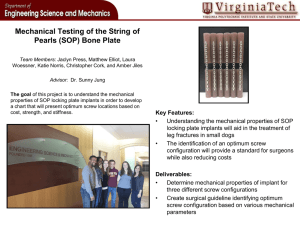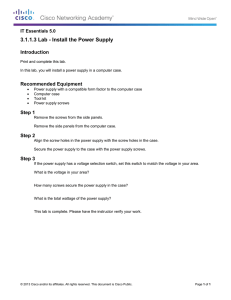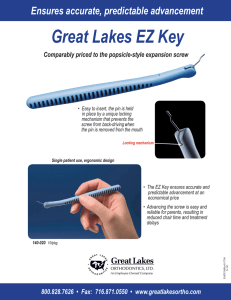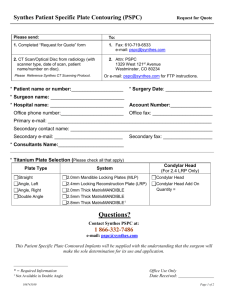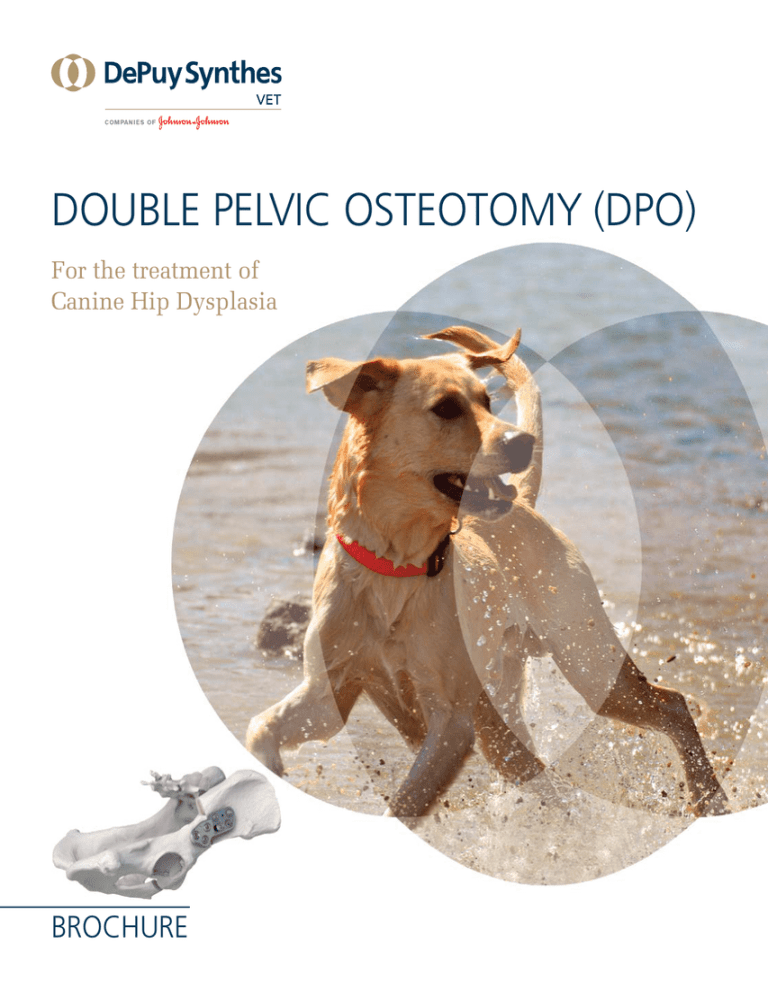
DOUbLE PELVIC OSTEOTOmy (DPO)
For the treatment of
Canine Hip Dysplasia
bROCHURE
Canine Hip Dysplasia is a common orthopedic condition and is caused
by abnormal development of the hip joint, including joint laxity and
incongruency. Hip Dysplasia results in the development of arthritis and
eventually degenerative joint disease. Common symptoms of Hip Dysplasia
are lameness, abnormal gait, reluctance to rise, soreness after exercise, and
hind limb stiffness. Some dogs initially do not show any symptoms.
Physical examination should include an Ortolani Test to detect hip joint laxity.
Radiographs are required to confirm hip laxity and to determine if the dog is
a good candidate for surgery. Typical views include: V/D pelvis, Frog leg V/D
pelvis, Distraction and compression V/D pelvis and DAR view pelvis.
To ensure positive clinical outcomes, DPO should not be performed in patients
who have pre-existing conditions, which could compromise the strength of
the pelvic bone, or any radiographic evidence of degenerative changes in the
coxofemoral joints. DPO should be avoided in patients less than 5 months old.
Early diagnosis is very important because many patients who could have
benefited from this procedure are not diagnosed with hip dysplasia early
enough to be candidates for the DPO procedure.
DePuy Synthes Vet DPO/TPO Plates
WHAT IS DPO?
Double (DPO) and Triple Pelvic Osteotomies (TPO) are
two prophylactic procedures used on immature dogs
to treat Canine Hip Dysplasia. both procedures
involve osteotomies of the pelvis, to allow for
rotation of the acetabulum and improved acetabular
coverage of the femoral head.
important: the earlier DPO/tPO Surgery is
performed, the better the long-term result.1
DPO is a newer and generally preferred surgical
procedure in which two separate osteotomies are
performed, and the acetabulum is then rotated
to cover more of the femoral head, allowing
improved joint function. The intact ischium is
what differentiates a DPO from a TPO2.
What are the differences between DPO and TPO Procedures?
DPO2,3
tPO2,3
Osteotomy
Two osteotomies (pubis and ilium)
Three osteotomies (ischium, pubis, and ilium)
Complications
• Ilial side screw loosening
• Difficult to rotate acetabulum
•
•
•
•
Advantages
• Only two cuts need to be made • Easier to rotate
• Less complications
• Longer clinical history
Sacral side screw loosening
Pelvic narrowing
Excessive head coverage
more healing complications from ischium
osteotomy
References
1. Vezzoni A. Early Diagnosis of CHD and Case Selection. World Veterinary Orthopedic Congress,
Sept 15 – 18, 2010.
2. Vezzoni A, boiocchi S, Vezzoni l, et al. Double pelvic osteotomy for the treatment of hip
dysplasia in young dogs. VCOT. 2010; 6:444-452.
3. Rose S, Peck J, Tano C, et al. Effect of a locking triple pelvic osetotomy plate on screw loosening
in 26 dogs. Vet Surg. 2012;41: 156-162.
DPO/TPO Plates
DePuy Synthes Vet
1
Why DePuy Synthes VET DPO Constructs?
Plate Design
Screw Holes
The DePuy Synthes Vet DPO plate is designed with
two distinct screw-hole technologies to accommodate
all plating modalities. The plate includes three stacked
Combi® Holes on the caudal side, and three stacked
Combi Holes and one locking compression plate
(LCP)® Combi Hole on the cranial side.
The stacked Combi Hole in the plate accepts either
cortex or locking screws. If locking screws are to be
used in conjunction with cortex screws on the same
side of the plate, the cortex screws must be inserted
and tightened first, before any locking screws are
inserted. If cortex screws are used, the plate must be
appropriately contoured to the bone to ensure good
bone plate contact.
Fixed-angle Stability
The threads on the head of the locking screws lock
into the threaded plate holes to form a fixed-angle
construct that will increase load transfer between the
plate and bone. When compared to conventional
plate-and-screw constructs, the angular and axial
stability of locking screws increases the strength of
the construct under load without requiring precise
anatomical contouring.
Anatomical Contour
The anatomically shaped DPO plate is contoured
to match the ilial shaft and to allow clearance for
acetabular flare and the tuberosity for the rectis
femoris muscle origin.
Optimized screw
angulations
The LCP Combi Hole accepts either cortex screws or
locking screws. The cortex screw should be placed in
the unthreaded portion of the Combi Hole in either
a loaded or neutral position. Alternatively, a locking
screw may be used in the threaded portion of the
Combi Hole when indicated.
Stacked Combi Holes accept
locking or cortex screws
K-wires holes for temporary
stabilization (1.6 mm)
Caudal
Cranial
Ability to perform either
DPO or TPO with the
same plate
Precontoured shape
for anatomic fit
Combi Hole accepts
locking or cortex
screws
2 DePuy Synthes Vet DPO/TPO Plates
WHy DEPUy SyNTHES VET DPO CONSTRUCTS?
LOCKINg SCREWS
Screw Head
The tapered, double-lead machine thread on the
head of the locking screw engages the threads of the
locking plate holes. The resulting fixed-angle construct
provides stable fixation of the bone fragments without
having to compress the plate to the bone. A perfectly
contoured plate is therefore not required to achieve
fixation and maintain proper alignment.
STARDRIVE Recess
Double-lead locking threads
mate with the threaded
portion of the plate
thread Profile
because locking screws do not compress the plate
to the bone, the “pull-out” mode of failure is not
applicable to locking screws. For this reason, locking
screws are made with a smaller thread profile and a
larger core diameter. This results in increased mechanical
strength over comparably sized cortex screws.1
Self-tapping flutes
Drive Mechanism
The STARDRIVETm Recess of a locking screw provides
three significant improvements over an internal hex
drive. First, “stripping” of the screw head is minimized
as a failure mode, which results in a much higher
tolerance to wear for the screwdriver.1 Second, the
tapered STARDRIVE Recess provides automatic screw
retention without the need for an additional screw
holding mechanism. Third, the more efficient
STARDRIVE Recess allows a smaller screw head and
allows the screw head to sit flush with the plate.
DPO/TPO Plates
DePuy Synthes Vet
3
Who is DePuy Synthes Vet?
DePuy Synthes Companies is a leading global medical
device company. Through its nine product groups
(Vet, Joint Reconstruction, Trauma, Spine, Sports Medicine,
Codman Neuro, Craniomaxillofacial, Power Tools and
Biomaterials) it develops, produces, and markets
instruments, implants and biomaterials for the surgical
fixation, correction, and regeneration of both the animal
and human skeleton and its soft tissues.
Caution: DePuy Synthes Companies of Johnson & Johnson implants and instruments
are manufactured with proprietary processes that produce superior products to
those created by conventional manufacturing processes. Though other companies
may be able to estimate the DePuy Synthes Companies general product design,
DePuy Synthes Companies product dimensions are proprietary. The precision
design of DePuy Synthes Companies products is very important for long-term
product function and optimal fit between implants.
Only the finest quality materials are used to manufacture DePuy Synthes Companies
implants. The metals DePuy Synthes Companies uses have been scientifically
proven to be of the best biocompatibility and quality available today.
With these features and qualities, the mixing of DePuy Synthes Companies
implants with the implants from other companies is not recommended. The
overall performance may be compromised due to differences in design, chemical
composition, mechanical properties, and quality.
Given these qualities are trade-secret, no competitor of DePuy Synthes Companies
can make a genuine claim “the same as DePuy Synthes Companies.” Combining
implants from other companies with DePuy Synthes Companies implants could
reduce product performance. Consequently, it is strongly recommended to not
mix parts from different manufacturers.
4 DePuy Synthes Vet DPO/TPO Plates
Implants
3.5 mm DPO/ TPO Plate, 44 mm long,
3.2 mm thick
VP4601.L7
20°, Left
VP4601.R7
20°, Right
VP4602.L7
25°, Left
VP4602.R7
25°, Right
VP4603.L7
30°, Left
VP4603.R7
30°, Right
3.5 mm Locking Screws, self-tapping, with
StarDrive™ Recess
VS303.010–
10 mm–40 mm (in 2 mm increments)
VS303.040
VS303.045–
45 mm–70 mm (in 5 mm increments)
VS303.070
3.5 mm Cortex Screws, self-tapping
VS302.010–
10 mm–50 mm (in 2 mm increments)
VS302.050
VS302.055–
55 mm–70 mm (in 5 mm increments)
VS302.070
Also available
3.5 mm Cortex Screws, non-self-tapping
VS301.010–
10 mm–50 mm (in 2 mm increments)
VS301.040
VS301.045–
45 mm–70 mm (in 5 mm increments)
VS301.070
DPO/TPO Plates DePuy Synthes Vet 5
Limited Warranty and Disclaimer: DePuy Synthes Vet products are sold with a limited warranty to the original purchaser against
defects in workmanship and materials. Any other express or implied warranties, including warranties of merchantability or fitness,
are hereby disclaimed.
WARNING: In the USA, this product has labeling limitations. See package insert for complete information.
CAUTION: USA Law restricts these devices to sale by or on the order of a physician.
Not all products are currently available in all markets.
DePuy Synthes Vet
1302 Wrights Lane East
West Chester, PA 19380
Telephone: (610) 719-5000
To order: (800) 523-0322
www.synthesvet.com
© DePuy Synthes Vet, a division of DOI 2015. All rights reserved.
DSUS/VET/0914/0027 1/15

